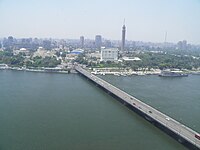Qasr El Nil Asr El Nil | |
|---|---|
 View of the Qasr El Nil Bridge, with Gezira/Zamalek Island in the background | |
| Coordinates | 30°02′37″N 31°13′46″E / 30.043747°N 31.229464°E |
| Carries | Tahrir Street[1] |
| Crosses | Nile River |
| Characteristics | |
| Design | swing bridge, arch[1] |
| Material | Steel[1] |
| Total length | 1 932 m[1] |
| No. of spans | 7 |
| History | |
| Designer | Ralph Anthony Freeman[1] |
| Engineering design by | Dorman, Long and Co. Ltd.[1] |
| Construction start | 1931[1] |
| Construction end | 1933[1] |
| Construction cost | E£308,000 |
| Opened | June 6, 1933 |
| Replaces | El Gezira Bridge (1872)[1] |
| Location | |
 | |
The Qasr el Nil Bridge (originally named Khedive Ismail Bridge, Egyptian Arabic: Asr el Nil Bridge), is a historic swing bridge structure dating from 1931 which replaced the first bridge to span the Nile River in central Cairo, Egypt.[2] It connects Tahrir Square in Downtown Cairo on the east bank of the river, to the southern end of Gezira/Zamalek Island. At the bridge's east and west approaches are four large bronze lion statues; they are late 19th-century works by Henri Alfred Jacquemart, French sculptor and animalier.
- ^ a b c d e f g h i Kasr el Nil Bridge - Structurae
- ^ Stephen, F W (1935-01-01). "The new khedive ismail bridge, cairo, egypt". Minutes of the Proceedings of the Institution of Civil Engineers. 240 (1935): 365–393. doi:10.1680/imotp.1935.15246.